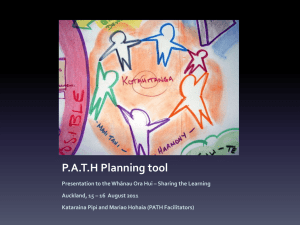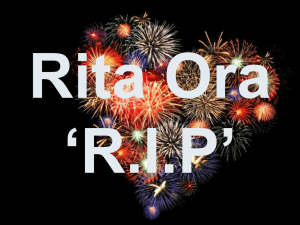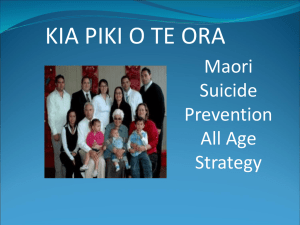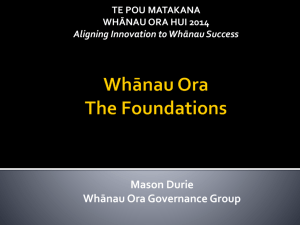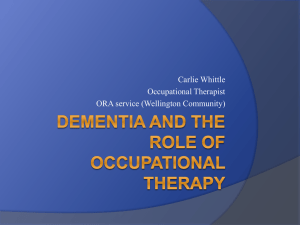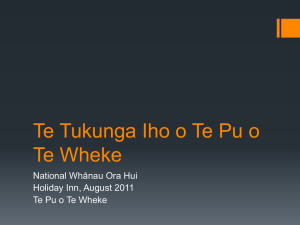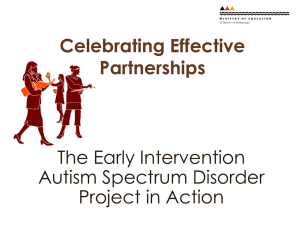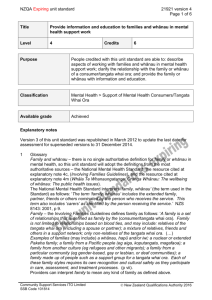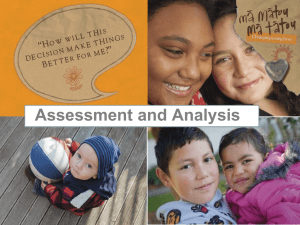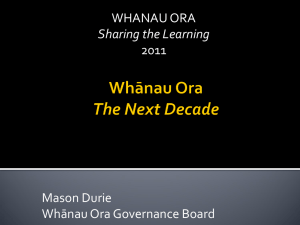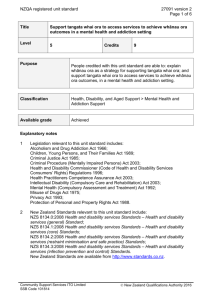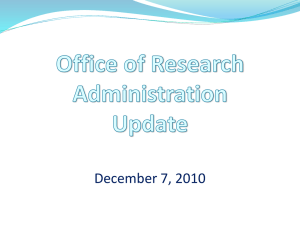Maori Models of Health - Asthma Foundation New Zealand
advertisement
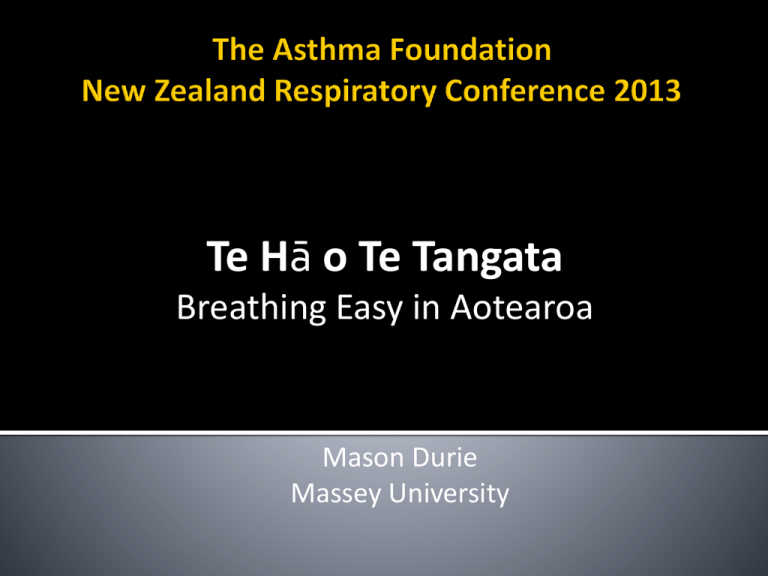
Te Hā o Te Tangata Breathing Easy in Aotearoa Mason Durie Massey University 1. 2. Māori understandings of health and sickness place importance on context The health context is shaped by four Pou Ora, key markers that underly the health-sickness continuum: 3. Hauora - Compatible environments Toi Ora – Knowledge transfers Whānau Ora Empowering relationships Mauri Ora - Enhanced potential Breathing will be easier when all four Pou are aligned and the human mauri is flourishing. Rangi and Papa Locked into an embrace that excluded light and life Rangi and Papa Forced apart by the offspring • Forests & birds • The elements • The seas and waters, fish • Crops • Ferns • Humankind Separation enabled Light and Life Environmental relationships, the common bonds The Whanaunga principle ‘While each species is unique, there is nonetheless a relationship between all species within the natural world. They are linked by time, inter-dependency and common needs.’ The Ahiowhio principle: ‘meaning comes from an outward (centrifugal) flow of energy; life is best understood by the relationships that exist between people and their environments.’ Building relationships An Outward flow of energy People, land, flora, fauna, water, air, cosmos Smaller entities make sense when viewed in relationship to larger entities Relationships and context are a basis for health Centrifugal direction ‘Health’ is widely used as a synonym for sickness ‘Hauora’ has been a common translation for ‘Health’ BUT Hau = wind, air, human breath, the security of home (hau kainga), fame, and vitality Ora = safety, satiation, survival, life Hauora positions people within a broad ecological context environments are drivers of health. The Hauora focus is on: associations between people with surroundings reducing risk from external natural and human threats identifying new and emerging environments A Māori world view of connectedness and inter-dependence provides a framework within which Hauora can be understood and its significance to modern times appreciated The implication is that health is essentially about ‘living in the world’ Human health cannot be fully understood without taking into account impacts from the wider environment Global environments The natural environment Urban environments Metropolitan environments Marae environments Home environments Work environments On-line environments Whānau environments Pastoral environments Horticultural environments School environments Roading environments Toi = Ora = knowledge art human origins birthplace wellness alive safe recovery Toi Ora Wellbeing associated with Indigeneity a sense of home knowledge and information Creativity Health is enhanced by old knowledge, heritage, and remembered ties to an ancestral home Health is linked to artistic expression, the use of symbols and metaphor derived from cultural experience, and the transfer of knowledge between generations Knowledge that is based on past journeys Knowledge that recalls longstanding world views Knowledge that can be used for ‘living well’ in the world Knowledge as a platform for health and wellbeing Ora safety life wellness Whānau Kaupapa whānau – group with a common interest Whakapapa whānau – group who share a common genealogy Māori families – twogenerational household Manaakitanga the capacity to care Pupuri Taonga capacity for guardianship Whakamana: capacity to empower whanau Whakatakato tikanga: capacity for planning Whakapumau tikanga: capacity to transmit culture, knowledge, between & within generations Whakawhanaungatanga: capacity for reaching consensus Interventions can be aimed at: changing the external impacts on relationships – an ecological approach (e.g. improving housing) building whānau capacities (e.g. building manaakitanga: capacity to care) Whanau self management Healthy whānau lifestyles Full whānau participation in society Confident whānau participation in te ao Māori Whānau economic security Whānau cohesion focus on the whānau as a whole builds on whānau strengths and increases whānau capacity six key operational elements: 1. whānau-centred methodologies shaped by the values, protocols and knowledge contained within te ao Maori 2. Intersectoral contributions 3. a primary focus on best outcomes for whānau, through integrated and comprehensive delivery 4. skilled whanau practitioners 5. expertise in whanau dynamics, relationships, aspirations 6. practices that increase whanau skills, knowledge, financial status, and self management (e.g. Online health records) Hauora Compatible environments Toi Ora Knowledge environments Whānau Ora Nurturing environments Mauri = a force for life human integrity human spirit human vitality individual uniqueness Ora = alert responsive lively Spiritually robust Culturally engaged Emotional vitality Positive thinking Energetic Able to participate in activities, events Sustainable & rewarding relationships Mauri Oho Indicators Spiritually robust Culturally engaged Emotional vitality Positive thinking Energetic Able to participate in activities, events Sustainable & rewarding relationships Inspired Inspirational Optimism Clear thinking Outward thinking Moving easy Breathing easy Liked Likeable Mauri Noho Languishing Spiritually robust Culturally engaged Emotional vitality Positive thinking Energetic Able to participate in activities, events Sustainable & rewarding relationships Cultural & spiritual alienation Negative emotions Knowledge gaps Listlessness Slow moving Laboured btreathing Negative relationships Social isolation Mauri Noho Languishing Spiritually robust Culturally engaged Emotional vitality Positive thinking Energetic Able to participate in activities, events Sustainable & rewarding relationships Wairua Hinengaro Cultural & spiritual alienation Negative emotions Knowledge gaps Tinana Whānau Listlessness slow moving laboured breathing Negative relationships Social isolation Creating environments where: the mauri can flourish and breathing is easy Hauora Compatible environments Natural & manmade environments Toi Ora Knowledge transfers Intellectual environments Whānau Ora Empowering relationships Social environments (home, work, leisure) Hauora Environs Toi Ora Knowledge Whānau Ora Family Mauri Ora Individuals Factors that prevent poor health, disease, sickness Green fields Organic farming Safe & nurturing environs School environs Occupational Health & safety Access to old knowledge Marae experience Exposure to matauranga Turangawaewae Food –Housing – Income Parenting Whānau inclusion Whānau wealth Whānau cohesion Whānau modelling Education Employment Personal resilience & social skills Self determination Exercise, sport, recreation Risk Factors that can lead to disease, sickness Alcohol Housing Ag.-Hort sprays Traffic density Natural & man made disasters Food standards Alienation from heritage, culture, old knowledge. Discrimination, racism, stigma Family dysfunction, child neglect Poverty Violence Cultural alienation Educational failure Physical inactivity Unemployment Lifestyles – tobacco, drugs, alcohol Work stress Detached from a past ‘Breathing Easy’ Environments Personal Environments Family & Social Environments Mauri Ora Whānau Ora Natural & Man-made Heritage & Environments cultural environments Toi Ora Family, work, Heritage & Internal & culture ‘inner’ social Knowledge environments environments environments Hauora Natural & man-made environments The Asthma Foundation New Zealand Respiratory Conference 2013 The overall challenge for preventing and managing sickness and disease is to create environments where ‘breathing can be easy’ Stay well Kia Ora Māori understandings of health and sickness place as much importance on context as on individual experience 2. The health context is shaped by four Pou Ora, key markers that underly the health-sickness continuum: 1. 3. Hauora - Compatible environments Toi Ora – Knowledge transfers Whānau Ora - Empowering relationships Mauri Ora - Enhanced potential Breathing will be easier when all four Pou are aligned and the human mauri is flourishing.
